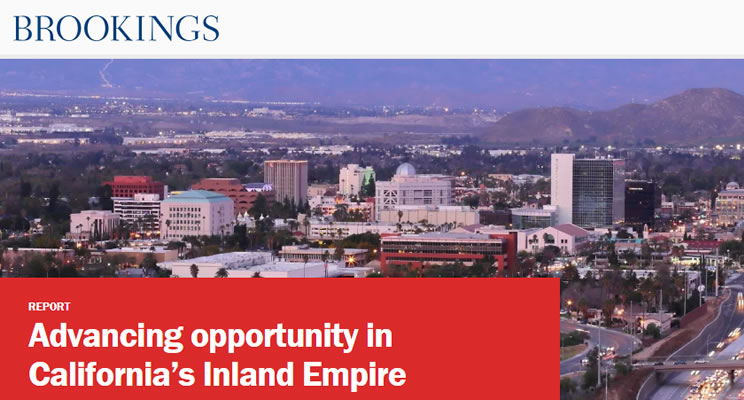New Brookings research reveals “Opportunity Industries” that concentrate good jobs in California’s Inland Empire
Riverside, CA – The Brookings Metropolitan Policy Program released new research today that examines the presence of “good jobs” across industries and occupations in California’s Inland Empire region, encompassing Riverside and San Bernardino counties. The report, Advancing opportunity in California’s Inland Empire, inventories “good” jobs that provide middle-class wages, benefits, and stable employment, particularly for the 1.3 million prime-age workers in the region who do not hold a bachelor’s degree. Importantly, the report also identifies “promising jobs” that provide stepping stones to the middle class over time.
Despite years of exceptionally fast job creation, the report finds that a persistently high portion of the Inland Empire’s workers and families still struggle to make ends meet, and its middle class remains smaller today than prior to the Great Recession. Behind these trends, the report shows that the region has generated growth in industries that provide too few “good jobs” or opportunities for career advancement.
Of the region’s nearly 1.45 million jobs, only 31 percent (445,000) qualify as good or promising for sub-baccalaureate workers, and another 15 percent (215,000) are held by high-skill workers with at least a bachelor’s degree. The remaining 54 percent (784,000) of the region’s jobs are neither good nor promising for workers of any level educational. Roughly 347,500 workers that hold these “other” jobs need a good or promising job in order to earn a family-sustaining wage—a jobs deficit that will not be closed if the region continues on its current economic trajectory.
Lead author Chad Shearer, Senior Research Associate at the Brookings Metropolitan Policy Program, said, “The Inland Empire’s economy has generated a remarkable number of jobs, but too few that can lead to the middle class. This research reveals both challenges and possibilities to spur both economic growth and opportunity for the region’s workers and firms, especially given the threat of automation in its core industries.”
Investing in “Opportunity Industries” can increase the Inland Empire’s stock of good jobs. A select set of well-established industries that are central drivers of the Inland Empire’s economy also concentrate good and promising jobs, particularly logistics and advanced manufacturing. However, to ensure sustainability and to benefit workers, those sectors can be better supported in adopting innovations and moving up the value chain. Additionally, the region can focus economic development efforts on emerging specializations that disproportionately generate good jobs—such as those related to technology in energy and emissions, information, and professional and business services.
Providing education and workforce supports can improve workers’ mobility toward good jobs. On the path to obtaining a good job, over 70 percent of the region’s workers without a bachelor’s degree will switch between completely different types of occupations. This type of significant career change is critical to economic mobility, but requires a different set of creativity, reasoning, and communication skills not typically taught in high school or technical training programs.
Paulette Brown-Hinds and Al Arguello, co-chairs of a regional coalition of business, government, labor, education, and civic leaders called Inland Economic Growth and Opportunity (IEGO), said, “This new report from Brookings provides powerful insights into how regional leaders can make targeted improvements in quality job growth by harnessing existing local economic assets. This work has already begun. The community leaders behind the Inland Economic Growth and Opportunity initiative have been focused on how this research can inform how the region continues to grow the middle class. We look forward to using this data to further inform our decision-making and to drive outcomes to improve the overall quality of life in the Inland Empire.”
The report is available here: https://brook.gs/2EoYFOC

